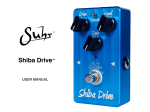Download your product manual here
Transcript
User Manual INTRODUCTION To all residents of the European Union Important environmental information about this product This symbol on the device or the package indicates that disposal of the device after its lifecycle could harm the environment. Do not dispose of the unit (or batteries) as unsorted municipal waste; it should be taken to a specialized company for recycling. This device should be returned to your distributor or to local recycling services. Respect the local environmental rules. If in doubt, contact your local waste disposal authorities. All parts used in the production of this product are RoHS compliant according to directive 2002/95/EC. Please read this manual before using this pedal as it contains important information about operating the unit. Thank you for using this product. If it was damaged in transit, don’t install or use it and contact us. FEATURES The ValvetteTM Custom Drive is a hand built true bypass overdrive pedal that creates various boost / overdrive effects. By adjusting the controls the pedal can be made to act as a buffer, clean boost, treble boost and overdrive circuit. Various tonal variations are possible using the tone control and bright switch The Custom Drive can be powered by a standard 9V battery or by an optional AC adaptor. PANEL DESCRIPTIONS 1. AC Adaptor Jack Accepts connection of an optional AC adaptor. This way you can play without being concerned about the remaining battery power. Please make sure you use a stabilized and filtered 9-18 VDC properly rated power supply. Bear in mind that over dimensioned and non filtered power supplies can create excessive hum. This is not a pedal malfunction. Any commercially available high quality unit with a center negative connection should work. It’s o.k. to keep the battery in the unit while using a power adaptor. In fact it’s actually a good idea. If ever the power adaptor gets unplugged while playing, the pedal will continue to do it’s job on battery power. 2. On/Off indicator This blue L.E.D. indicator shows the operational state of the effect and also doubles as a battery status indicator. The indicator lights when the effect is on. If the indicator goes dim or no longer lights while the effect is switched on then the battery is depleted and should be replaced immediately. Please note that the On/Off indicator does not show whether the device is powered or not. 3. Output Jack The Output Jack is used to connect the unit to an amplifier or other devices. 4. True Bypass Footswitch This switch alternates the unit between on or off. Note that because of the true bypass switching sound will travel through the unit even when unpowered in the off position. 5. Input Jack This jack accepts input signals (coming from a guitar, some other electric or electronic musical instrument, or another effects unit). The input jack also serves as the power switch. Power is turned on whenever a plug is present in the input jack and is turned off when the plug is disconnected. When the unit is not in use the input jack should always be disconnected to avoid battery drainage. 6. Gain knob This knob controls the amount of drive that is applied to the input signal and the level of sustain. Rotating the knob clockwise creates more profound alteration of the original sound and as a result longer sustain times. 7. Volume knob This knob adjusts the level of the effect output. Adjust this control to get the desired balance between the bypassed signal when the unit is switched off and the output signal of the unit when it’s engaged. 8. Tone knob This knob controls the tone of the drive circuit. Rotating the knob clockwise inserts more high frequency content into the overdriven signal, resulting in more cutting sounds. Rotating the knob counterclockwise will create smoother, warmer sounds. 9. Bright switch This switch will extend the range of the tone control by shifting the high frequency content up when it’s engaged. MAKING THE CONNECTIONS * Inserting a plug into the input jack will automatically switch the power to the unit on. * Before connecting or disconnecting any patch cords, be sure all the volume controls in your system are turned all the way down. This will help prevent damage to any system components. OPERATING THE UNIT 1. After you have made the necessary connections, set the knobs to their 12 ‘o clock positions 2. Depress the footswitch to turn the effect on. (the blue L.E.D. indicator should be lit) 3. Adjust the depth of the overdrive effect with the Gain control (6) 4. Adjust the level of the output signal with the Volume control (7) 5. Adjust the Tone control (8) to adjust the amount of high frequency content of the effect. 6. Switch the Bright switch (9) to the on position (up) to shift the range of the Tone control (8) upwards CHANGING THE BATTERY When the indicator light goes dim or no longer lights up while the effect is on, it means the battery has been depleted and is in need of replacement. To replace the battery follow the procedure outlined below. 1. Unplug the AC adaptor from the unit (if you are using one) and turn the unit upside down. 2. Remove the four Philips screws situated at the four corners of the unit with a correct size screwdriver. Take care not to strip the screw heads. 3. Remove the rear cover 4. Remove the old battery from the compartment next to the printed circuit board and remove the attached snap connector 5. Connect the new battery and the snap connector observing the battery polarity. 6. Carefully push the new battery back into the empty compartment. 7. re-align the rear cover observing the rubber strip that needs to be across the battery to keep it firmly in place. 8. re-insert the four Phillips screws into the enclosure and tighten with a correct fitting screwdriver. Do not over tighten as this will risk stripping the screws or the screw heads. SAMPLE SETTINGS Buffer Crunch Clean Boost Warm Lead Treble Boost Hot Lead SETTING MEMO ……………………….. ………………………. ………………………. ……………………….. ……………………….. ………………………. ………………………. ……………………….. SPECIFICATIONS Custom Drive Nominal Input Level Input Impedance Nominal Output Level Output Impedance Equivalent Input Noise Level -20 dBu 2M Ohm -20 dBu 100k Ohm Max. -120 dBu (IHF-A, Typ.) Controls Footswitch, Gain knob, Volume knob, Tone knob, Bright switch On/Off indicator (also serves as a battery indicator) Input jack, Output jack, AC adaptor jack (9-18VDC) 9-18VDC : Dry Battery 9V type (6F22/9V), AC adaptor (Negative center pin) 4.8 mA (off), 5.8 mA (on) @ 9VDC Battery life varies depending on actual conditions of use. 71(W) x 120(L) x 60(H) mm 325 g including battery AC adaptor Indicator Connectors Power Supply Current Draw Dimensions Weight Options * 0 dBu = 0.775 V rms * Specifications and/or appearance of this unit are subject to change without prior notice.

















